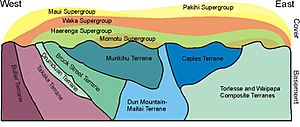Takaka Terrane facts for kids
Quick facts for kids Takaka TerraneStratigraphic range: Cambrian-Devonian ~510–400Ma |
|
|---|---|
 |
|
| Type | Terrane |
| Unit of | Austral Superprovince Western Province |
| Sub-units | Haupiri, Devil River Volcanics, Mount Patriarch, Mount Arthur, Ellis, Edgecumbe, Cameron & Pegasus Groups |
| Underlies | Tuhua Intrusive, Waka & Haerenga Supergroups |
| Lithology | |
| Primary | Sandstone, marble, basalt |
| Location | |
| Region | Tasman District |
| Country | |
| Type section | |
| Named for | Takaka Hill |
 Cross-section of New Zealand's stratigraphy |
|
The Takaka Terrane is a special piece of Earth's crust found in the South Island of New Zealand. Think of a terrane as a large block of rock that has moved a long way. This one is from the Paleozoic Era, which was a very long time ago.
You can see a lot of the Takaka Terrane in Kahurangi National Park in the Tasman District. It's mostly made of marble (a type of rock) and rocks that came from volcanoes. But it also has many other kinds of rocks.
The rocks in the Takaka Terrane are very old, dating from about 510 to 400 million years ago. This includes some of New Zealand's oldest rocks! These ancient rocks are found in the Cobb Valley in north-west Nelson.
In the Cobb Valley, there's a famous rock called "Trilobite Rock." It's a large stone that was dropped by a glacier long ago. This rock is made from the old shells of tiny sea creatures called trilobites. People even mined a material called asbestos from the Takaka Terrane in the Cobb Valley between the late 1880s and 1917.
The Takaka Terrane has been squashed and changed a lot over millions of years. It also has many large blobs of hardened magma, called batholiths, pushed into it.
Contents
What is the Takaka Terrane Made Of?
The Takaka Terrane has two main types of igneous rocks. Igneous rocks are formed from cooled magma or lava.
- The Devil River Volcanics Group formed from volcanoes near a plate boundary. These rocks are from the Middle to Late Cambrian period.
- The Gendarme Dolerite formed when the Earth's crust pulled apart. These rocks are from the latest Cambrian to Early Ordovician period.
Rocks from the Devil River Volcanics Group contain fossils of ancient sea creatures. These include trilobites, brachiopods (shellfish), and conodonts (small, tooth-like fossils).
Some of the sedimentary rocks in the Takaka Terrane, like the Haupiri Group, probably formed in a "back-arc basin." This is a deep area of the ocean behind a chain of volcanic islands.
The Famous Arthur Marble
A very special rock in the Takaka Terrane is the Arthur Marble. You can find it on Takaka Hill and Mount Arthur. This marble is from the Ordovician period.
Scientists think that the Takaka Terrane might be connected to similar rocks found in Tasmania, Australia. They believe these landmasses were once joined and then separated when the Tasman Sea opened up.
Caves and Karst Landscapes
The Arthur Marble has a lot of calcium carbonate, which is the same stuff that makes up seashells. Because of this, rain and groundwater can slowly dissolve the marble. This process is called weathering.
When the marble dissolves, it creates a special type of landscape called karst. Karst areas often have amazing features like sinkholes, underground rivers, and large cave systems.
Some famous cave systems in the Takaka Terrane include Harwood Hole and the Riuwaka Resurgence. These caves are popular for exploring and show how water can shape the land over time.
Images for kids



